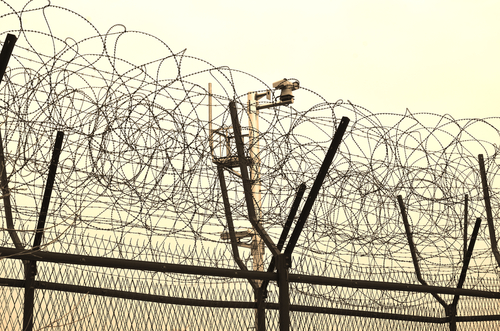 The South Korean government is reportedly using Microsoft’s Kinect motion-based game controller to monitor the heavily guarded DMZ (Demilitarized Zone) that separates the country from North Korea. The brainchild of freelance South Korean developer Jae Kwan Ko, the system is reportedly capable of differentiating between people and animals. (Hat tip to Kotaku, which originally ferreted out the story from South Korean publication Hankooki.) That makes it superior to the infrared systems already in use along the DMZ, which have a harder time determining whether a moving object is human. The Kinect-based system can send alerts of suspicious activity to the nearest military outpost. While the South Korean government reportedly installed the hardware at select portions of the DMZ last year, news about it is only emerging now—and details are relatively scarce, considering how this is a military project. Despite that secrecy, the South Korean government is playing up Jae Kwan Ko’s contributions, highlighting him in the local media as an example of innovation and creative drive. Largely self-taught, he makes money by building apps for various mobile platforms—most of which, presumably, have nothing to do with detecting military threats. Microsoft originally intended the Kinect controller as a way to play Xbox 360 games via body movements and voice control. Researchers and tech pros, however, quickly realized that the hardware, if hacked, could provide the foundation for all sorts of non-gaming uses, such as controlling robots or modeling objects in 3D. Microsoft initially pushed back against that reverse engineering, claiming that it would work with law enforcement to stop what it called “tampering,” before changing course and claiming that it had deliberately left the device open to modification. That early tension between Microsoft and the DIY community certainly didn’t stop the latter from finding multiple uses for Kinect technology. The hardware and software is now used in everything from academia to interactive dressing rooms to protecting borders. Image: meunierd/Shutterstock.com
The South Korean government is reportedly using Microsoft’s Kinect motion-based game controller to monitor the heavily guarded DMZ (Demilitarized Zone) that separates the country from North Korea. The brainchild of freelance South Korean developer Jae Kwan Ko, the system is reportedly capable of differentiating between people and animals. (Hat tip to Kotaku, which originally ferreted out the story from South Korean publication Hankooki.) That makes it superior to the infrared systems already in use along the DMZ, which have a harder time determining whether a moving object is human. The Kinect-based system can send alerts of suspicious activity to the nearest military outpost. While the South Korean government reportedly installed the hardware at select portions of the DMZ last year, news about it is only emerging now—and details are relatively scarce, considering how this is a military project. Despite that secrecy, the South Korean government is playing up Jae Kwan Ko’s contributions, highlighting him in the local media as an example of innovation and creative drive. Largely self-taught, he makes money by building apps for various mobile platforms—most of which, presumably, have nothing to do with detecting military threats. Microsoft originally intended the Kinect controller as a way to play Xbox 360 games via body movements and voice control. Researchers and tech pros, however, quickly realized that the hardware, if hacked, could provide the foundation for all sorts of non-gaming uses, such as controlling robots or modeling objects in 3D. Microsoft initially pushed back against that reverse engineering, claiming that it would work with law enforcement to stop what it called “tampering,” before changing course and claiming that it had deliberately left the device open to modification. That early tension between Microsoft and the DIY community certainly didn’t stop the latter from finding multiple uses for Kinect technology. The hardware and software is now used in everything from academia to interactive dressing rooms to protecting borders. Image: meunierd/Shutterstock.com South Koreans Using Kinect to Monitor DMZ
 The South Korean government is reportedly using Microsoft’s Kinect motion-based game controller to monitor the heavily guarded DMZ (Demilitarized Zone) that separates the country from North Korea. The brainchild of freelance South Korean developer Jae Kwan Ko, the system is reportedly capable of differentiating between people and animals. (Hat tip to Kotaku, which originally ferreted out the story from South Korean publication Hankooki.) That makes it superior to the infrared systems already in use along the DMZ, which have a harder time determining whether a moving object is human. The Kinect-based system can send alerts of suspicious activity to the nearest military outpost. While the South Korean government reportedly installed the hardware at select portions of the DMZ last year, news about it is only emerging now—and details are relatively scarce, considering how this is a military project. Despite that secrecy, the South Korean government is playing up Jae Kwan Ko’s contributions, highlighting him in the local media as an example of innovation and creative drive. Largely self-taught, he makes money by building apps for various mobile platforms—most of which, presumably, have nothing to do with detecting military threats. Microsoft originally intended the Kinect controller as a way to play Xbox 360 games via body movements and voice control. Researchers and tech pros, however, quickly realized that the hardware, if hacked, could provide the foundation for all sorts of non-gaming uses, such as controlling robots or modeling objects in 3D. Microsoft initially pushed back against that reverse engineering, claiming that it would work with law enforcement to stop what it called “tampering,” before changing course and claiming that it had deliberately left the device open to modification. That early tension between Microsoft and the DIY community certainly didn’t stop the latter from finding multiple uses for Kinect technology. The hardware and software is now used in everything from academia to interactive dressing rooms to protecting borders. Image: meunierd/Shutterstock.com
The South Korean government is reportedly using Microsoft’s Kinect motion-based game controller to monitor the heavily guarded DMZ (Demilitarized Zone) that separates the country from North Korea. The brainchild of freelance South Korean developer Jae Kwan Ko, the system is reportedly capable of differentiating between people and animals. (Hat tip to Kotaku, which originally ferreted out the story from South Korean publication Hankooki.) That makes it superior to the infrared systems already in use along the DMZ, which have a harder time determining whether a moving object is human. The Kinect-based system can send alerts of suspicious activity to the nearest military outpost. While the South Korean government reportedly installed the hardware at select portions of the DMZ last year, news about it is only emerging now—and details are relatively scarce, considering how this is a military project. Despite that secrecy, the South Korean government is playing up Jae Kwan Ko’s contributions, highlighting him in the local media as an example of innovation and creative drive. Largely self-taught, he makes money by building apps for various mobile platforms—most of which, presumably, have nothing to do with detecting military threats. Microsoft originally intended the Kinect controller as a way to play Xbox 360 games via body movements and voice control. Researchers and tech pros, however, quickly realized that the hardware, if hacked, could provide the foundation for all sorts of non-gaming uses, such as controlling robots or modeling objects in 3D. Microsoft initially pushed back against that reverse engineering, claiming that it would work with law enforcement to stop what it called “tampering,” before changing course and claiming that it had deliberately left the device open to modification. That early tension between Microsoft and the DIY community certainly didn’t stop the latter from finding multiple uses for Kinect technology. The hardware and software is now used in everything from academia to interactive dressing rooms to protecting borders. Image: meunierd/Shutterstock.com 
